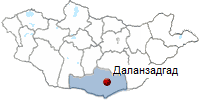Yolyn am canyon mongolia, Yolyn Am Valley, Gurvansaikhan Natural Park. South Gobi, Umnogovi aimag.
THE REGIONS OF MONGOLIA
UMNUGOBI AIMAG
YOLYN AM CANYON


Yolyn Am (Mongolian: Ёлын Ам, Lammergeier Valley) is a deep and narrow gorge
in the Gurvan Saikhan Mountains of southern Mongolia. The valley is named after
the Lammergeier, which is called Yol in Mongolian. The Lammergeier is an Old
World vulture, hence the name is often translated to Valley of the Vultures or
Valley of the Eagles.
The valley is located within Gobi Gurvansaikhan National Park.
Yolyn Am is found in the Zuun Saikhanii Nuruu (the Eastern Beauty) subrange
of the Gurvan Saikhan Mountains. The area, as part of the Gobi Desert, sees
little precipitation. However, Yolyn Am is notable for a deep ice field. The ice
field reaches several meters thick by the end of winter, and is several
kilometers long. In past years it remained year round, but the modern ice field
tends to disappear by September.
Apart from the lammergeir, both the Himalayan and Cinereous vulture can be
found in the gorge. Other birds that live in the gorge are the Altai snowcock,
wallcreeper and the Mongolian finch. Mammals that live in the valley include the
Argali, Siberian ibex and snow leopard.
Yolyn Am (Vulture's Mouth) was originally established to conserve the birdlife in the region, but it's now more famous for its dra-matic and very unusual scenery - it is a valley in the middle of the Gobi Desert, with metres-thick ice almost all year-round.
The small nature museum at the gate on the main road to Yolyn Am has a collection of dinosaur eggs and bones, stuffed birds and a snow leopard. There is also an ethnography museum in a ger, which is worth a visit.
Look out for the remarkable petrified wood lying by the roadside. The ranger office and museum sell some good souvenirs, including landscape paintings and, amaz-ingly, one of the best collections of Mongolian stamps in the country.
From the museum, the road continues for another 10km to a car park. From there, a pleasant 25-minute walk, following the stream, leads to a gorge full of ice. In winter, the ice is up to 10m high, and continues down the gorge for another 10km. It remains frozen for most of the year, except lor about a month starting in late August.
You can walk on the ice - but be careful, especially in late summer.
The surrounding hills offer plenty of opportunities for some fine, if somewhat strenuous, day hikes. If you are lucky you might spot ibex or argali sheep along the steep valley ridges.
INFORMATION:
PAGES OF THE PICTURE ALBUM
|